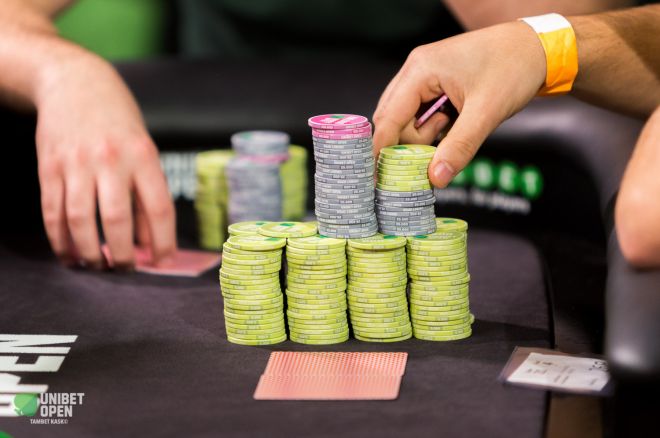Hand Reading and Bet Sizing in Small Stakes Cash Games

One of the best ways to increase your win rate in lower stakes cash games is to get good at reading opponents�� hands in various situations. This allows you to make tailor-made value bets that are based on what they are able to call. It also allows you to find that perfect bet size for your bluff.
Hand reading in small stakes cash games is never an exact science and I am no Daniel Negreanu. However, there are several specific clues that players frequently give off regarding the strength of their hand at the lower stakes. Let��s look at a few of these.
Preflop Action
At the lowest stakes online or live, when players just flat call your preflop raise this typically means they have some sort of non-premium though decent hand they don��t think is good enough to three-bet. Either that or they have a speculative hand or small pair, so we��re talking about hands like:
- AxJx, KxQx, KxJx
- 10x10x, 9x9x, 8x8x
- Ax5x-suited, 9x8x-suited
- 4x4x, 3x3x
Most players at these stakes will three-bet with their big premium hands (AxAx, KxKx, QxQx, JxJx, AxKx) a lot of the time. Based on opponents�� preflop responses to our opening raises, then, we can already begin to narrow down their ranges considerably.
Postflop Action
The hand reading process continues after the flop based on the actions that our opponent takes. Timing tells in the online game and physical tells when playing live can also come into play.
When somebody just flats your flop continuation bet at these stakes, it is usually some sort of weak made hand or a draw. They will be slow playing something big from time to time, but this is not the norm. And if they are, they will typically let you know later on in the hand with a raise on the turn or river.
If they call your c-bet quickly, then this is usually a dead tell that they are on this weak pair/draw range as well. The reason why is that if they were slow playing something big (or even calling with nothing to set up some sort of bluff later on), then they would often want to think about it for a moment. When they snap-call us, though, it typically means that they didn��t even consider their other options. This is what somebody with a mediocre hand would likely do.
If we assume that our opponent has something like middle pair or a flush draw a lot when just calling us postflop, we should continue to bet for value with all of our decent-to-good made hands. We should also continue to fire as a bluff on all boards that get progressively scarier for them and do not complete the obvious draws �� e.g., a board like 9?6?2?A?K?.
Custom Bet Sizing
Now that we can narrow down our opponents�� possible hands based on preflop and postflop actions, we can consider what the appropriate bet size will be to get the maximum value out of them or make them fold if we are bluffing. I am primarily speaking about the river here.
On the flop and turn, you should often just go ahead and bet the ��standard�� 60%-70% of the pot that is typical for these low stakes cash games whether you are betting for value or bluffing. However, once we get to the river we have the maximum amount of information about the strength of our opponent��s hand.
It would be a mistake at that point always to continue to bet these same amounts. Sometimes we should bet less, and sometimes we should even bet more.
Under-Betting the River to Get Value
If we get to the river and our opponent has been calling the whole way, as I mentioned before this is typically the sign of a weakish pair that is hanging on or a draw. If they have a missed draw, then obviously it doesn��t matter what amount we bet on the river, they are folding. However, if they have some sort of made hand it is very important that we get value here by making it an amount that they can��t say no to calling.
This is when you really need to use your hand reading skills. What sort of pair do you think your opponent is likely to have considering the preflop and flop action? Did the turn and river bring overcards to that pair? If so, then perhaps something like 40% of the pot or even less is the right amount to get a call.
This is especially the case if you think that they might be capable of hero calling you with bottom pair or even ace-high. Bombing the pot here against those hands would be a serious mistake.
The bottom line is that you want to put yourself in your opponents�� shoes here and ask yourself how much can they call considering the strength of their hand. Pot sizes are the biggest on the river and it is critical for your win rate that you consider what the optimal bet size is instead of just auto-firing like you might have done on earlier streets.
Over-Betting the River as a Bluff
This play is a little bit more complicated and not something I do nearly as often at the lower stakes versus the large amount of calling stations and bad players. However, there are a few situations where a bigger bet size might get them to fold a bit more readily when we are bluffing.
Again, the key here is to put yourself in your opponents�� position and try to narrow down what hand they are likely to have based on their preflop and postflop actions as well as the board. What do you think they called you with on the flop? Did the board get scarier for them? Were there any draws? Could you perhaps rep a draw that came in yourself?
If you think they might have something fairly decent, a bigger bet size of 80% of the pot or even more might just be the magic number to make them lay it down. You want them really to think about whether they want to make that call with their middle pair or weak top pair. You don��t want to give them an easy decision by betting too small.
It would be wise not to attempt this sort of thing very often against the recreational players who will call you down with anything. Also, you should be careful about tapping the well like this too many times against any regulars with whom you have an aggressive history or who are calling stations themselves (which is often the case at these stakes).
Conclusion
Learning how to read your opponent��s hand in small stakes cash games can really help you make the right play on the later streets and perhaps more importantly make the right bet size.
Handing reading is all about putting the pieces of the puzzle together based on your opponent��s actions throughout the hand. Despite what you might see on televised poker shows or in Hollywood depictions of the game, this isn��t about calling your opponent��s exact hand. This is about narrowing down their range to a specific type of hand such as flush draw, middle pair, top pair/weak kicker, and the like.
Once you get better at doing this, then you should pay close attention to your bet sizing �� especially on the river �� in order to make sure you get the most value when you have it and get the fold when you don��t.
Nathan ��BlackRain79�� Williams is the author of the popular micro stakes strategy books, Crushing the Microstakes and Modern Small Stakes. He also blogs regularly about all things related to the micros over at www.blackrain79.com.
Want to stay atop all the latest in the poker world? If so, make sure to get PokerNews updates on your social media outlets. Follow us on Twitter and find us on both Facebook and Google+!









